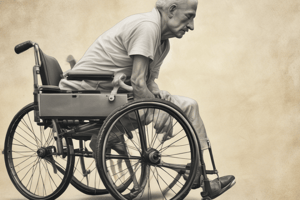Podcast
Questions and Answers
Which of the following aspects of pain is most closely related to the study of the nervous system?
Which of the following aspects of pain is most closely related to the study of the nervous system?
- Psychological
- Physiological (correct)
- Biochemical
- Anatomical
What is the primary focus of the anatomical basis of pain?
What is the primary focus of the anatomical basis of pain?
- The role of neurotransmitters in pain transmission
- The emotional response to pain
- The structure of the nervous system (correct)
- The cognitive processing of pain
Which of the following is NOT a level of pain processing?
Which of the following is NOT a level of pain processing?
- Peripheral
- Molecular (correct)
- Cerebral
- Spinal
What is the primary role of the psychological basis of pain?
What is the primary role of the psychological basis of pain?
What is the ultimate goal of understanding the anatomical, physiological, and psychological basis of pain and pain relief?
What is the ultimate goal of understanding the anatomical, physiological, and psychological basis of pain and pain relief?
Which theory of pain suggests that a specific nerve fiber is responsible for transmitting pain signals?
Which theory of pain suggests that a specific nerve fiber is responsible for transmitting pain signals?
What is the focus of Strong's Investigation of Cutaneous Pain?
What is the focus of Strong's Investigation of Cutaneous Pain?
What is the primary contribution of the Pattern Theory to the field of pain research?
What is the primary contribution of the Pattern Theory to the field of pain research?
What is a key difference between the Specificity Theory and other theories of pain?
What is a key difference between the Specificity Theory and other theories of pain?
Which of the following theories of pain is most closely related to the study of somaesthesis?
Which of the following theories of pain is most closely related to the study of somaesthesis?
Flashcards are hidden until you start studying
Study Notes
Theories of Pain
- Anatomical, physiological, and psychological frameworks explain pain and pain relief mechanisms.
- Pain is a complex experience involving sensory, emotional, and cognitive components.
Pattern Theory
- Suggests that pain perception occurs via patterns of nerve impulses rather than through specific pathways.
- Emphasizes that the brain interprets varying signals to create the sensation of pain.
- Represents a shift from traditional views on discrete pain signals to a holistic understanding of sensory feedback.
Strong's Investigation of Cutaneous Pain
- A significant study highlighting the perception of pain in the skin.
- Explores how specific stimuli can produce varied pain experiences.
- Provides foundational insights into the complexities of cutaneous pain and its implications for pain relief.
Specificity Theory
- Proposes that specific pain receptors and pathways act independently from other sensory modalities.
- Claims that pain is a direct result of activation in specialized neurons transmitting pain stimuli.
- Provides a contrasting viewpoint to pattern theory by suggesting a direct correlation between injury and pain perception.
Studying That Suits You
Use AI to generate personalized quizzes and flashcards to suit your learning preferences.



